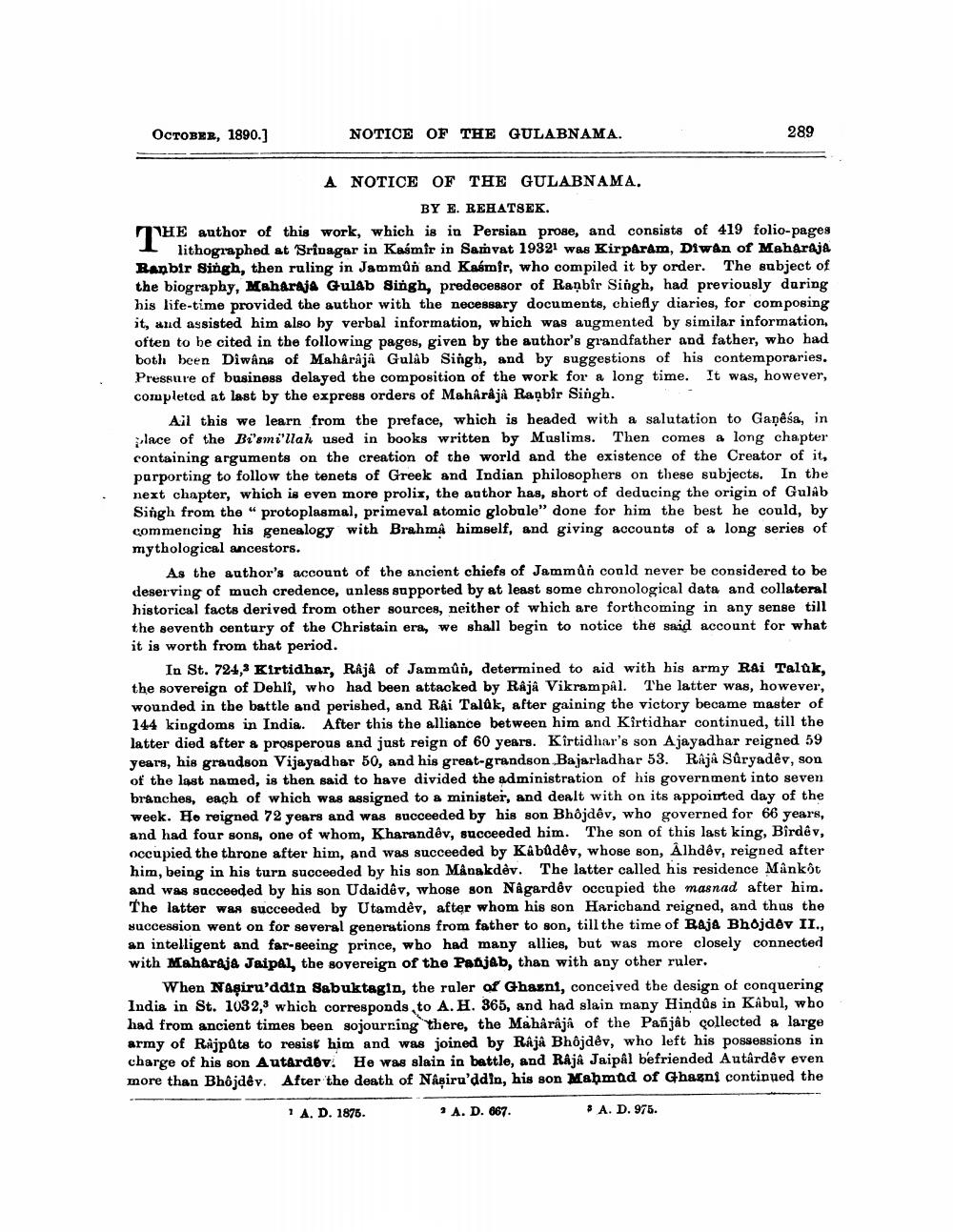________________
OCTOBER, 1890.]
NOTICE OF THE GULABNAMA.
289
A NOTICE OF THE GULABNAMA.
BY E. REHATSEK. N e author of this work, which is in Persian prose, and consists of 419 folio-pages
1 lithographed at Srinagar in Kasmir in Samvat 19321 was Kirparam, Diwan of Maharaja Ranbir Singh, then ruling in Jammun and Kasmir, who compiled it by order. The subject of the biography, Maharaja Gulab Singh, predecessor of Ranbir Singh, had previously during his life-time provided the author with the necessary documents, chiefly diaries, for composing it, and assisted him also by verbal information, which was augmented by similar information, often to be cited in the following pages, given by the author's grandfather and father, who had both been Diwâne of Maharaja Gulab Singh, and by suggestions of his contemporaries. Pressure of business delayed the composition of the work for a long time. It was, however, completed at last by the express orders of Maharaja Ranbir Singh.
All this we learn from the preface, which is headed with a salutation to Ganesa, in place of the Bi'smi'llah used in books written by Muslims. Then comes a long chapter containing arguments on the creation of the world and the existence of the Creator of it, parporting to follow the tenets of Greek and Indian philosophers on these subjects. In the next chapter, which is even more prolix, the author has, short of deducing the origin of Gulab Singh from the protoplasmal, primeval atomic globule" done for him the best he could, by commencing his genealogy with Brahmå himself, and giving accounts of a long series of mythological ancestors.
As the author's account of the ancient chiefs of Jammun conld never be considered to be deserving of much credence, unless supported by at least some chronological data and collateral historical facts derived from other sources, neither of which are forthcoming in any sense till the seventh century of the Christain era, we shall begin to notice the said account for what it is worth from that period.
In St. 724, Kirtidhar, RAJA of Jammûn, determined to aid with his army Rai Talak, the sovereign of Dehli, who had been attacked by Râjâ Vikrampal. The latter was, however, wounded in the battle and perished, and RÂi Talâk, after gaining the victory became master of 144 kingdoms in India. After this the alliance between him and Kirtidhar continued, till the latter died after a prosperous and just reign of 60 years. Kirtidhar's son Ajayadhar reigned 59 years, his graudson Vijayad har 50, and his great-grandson Bajarladhar 53. Raja Sûryadev, son of the last named, is then said to have divided the administration of his government into seven branches, each of which was assigned to a minister, and dealt with on its appointed day of the week. Ho reigned 72 years and was succeeded by his son Bhôjdêv, who governed for 66 years, and had four sons, one of whom, Kharandêv, succeeded him. The son of this last king, Birdêv, occupied the throne after him, and was succeeded by Kabûdêv, whose son, Alhdôv, reigned after him, being in his turn succeeded by his son Mânakdèv. The latter called his residence Mankôt and was sacceeded by his son Udaidêv, whose son Nâgardêv occupied the masnad after him. The latter was succeeded by Utamdev, after whom his son Harichand reigned, and thus the succession went on for several generations from father to son, till the time of Raja Bhojdev II., an intelligent and far-seeing prince, who had many allies, but was more closely connected with Maharaja Jaipal, the sovereign of the Panjab, than with any other ruler.
When Nasiru'ddin Sabuktagin, the ruler of Ghaeni, conceived the design of conquering India in St. 1032, which corresponds to A. H. 365, and had slain many Hindûs in Kabul, who had from ancient times been sojourning there, the Mahârâjâ of the Pañjâb collected a large army of Rijpats to resist him and was joined by Raja Bhojdév, who left his possessions in charge of his son Autardev. He was slain in battle, and RAJA Jaipal befriended Autârdøv even more than Bhôjdêy. After the death of Naşiru'ddin, his son Mahmad of Ghaxni continued the
1 A. D. 1875.
1 A. D. 667
* A. D. 975.




